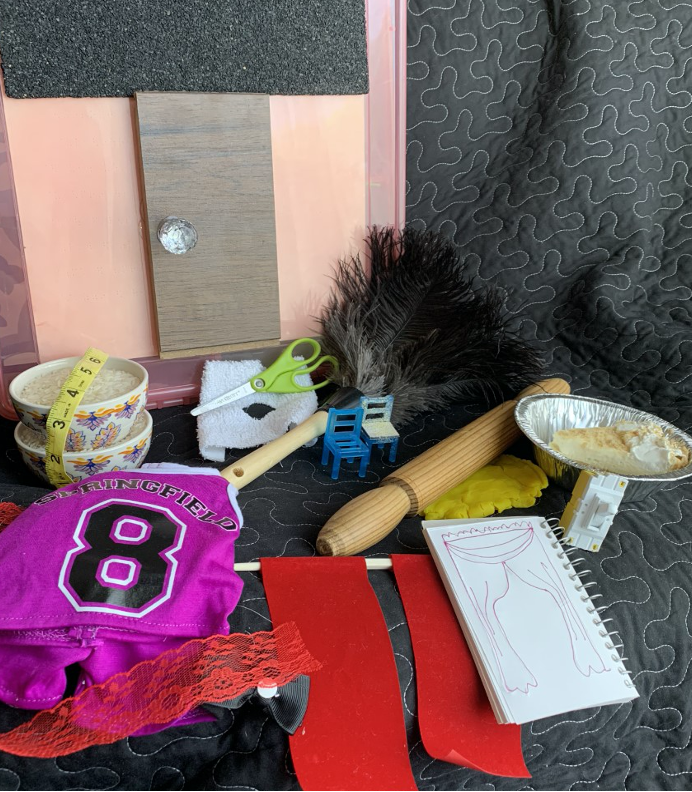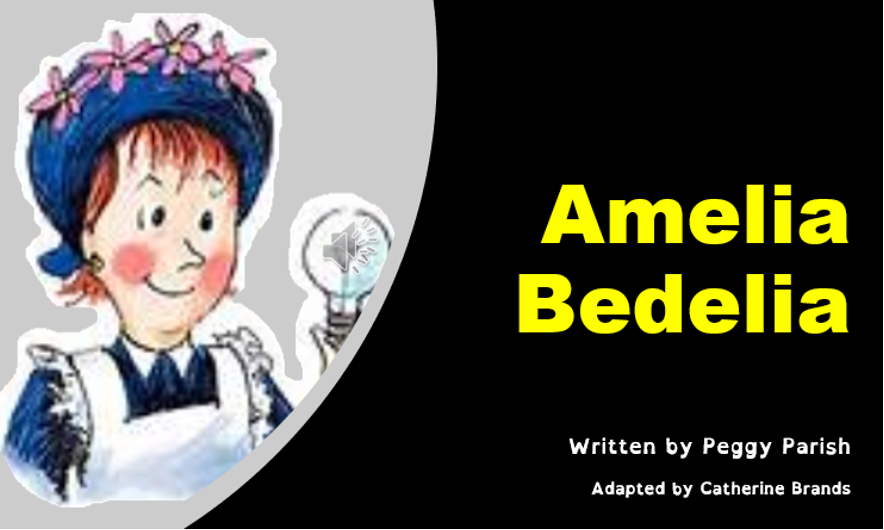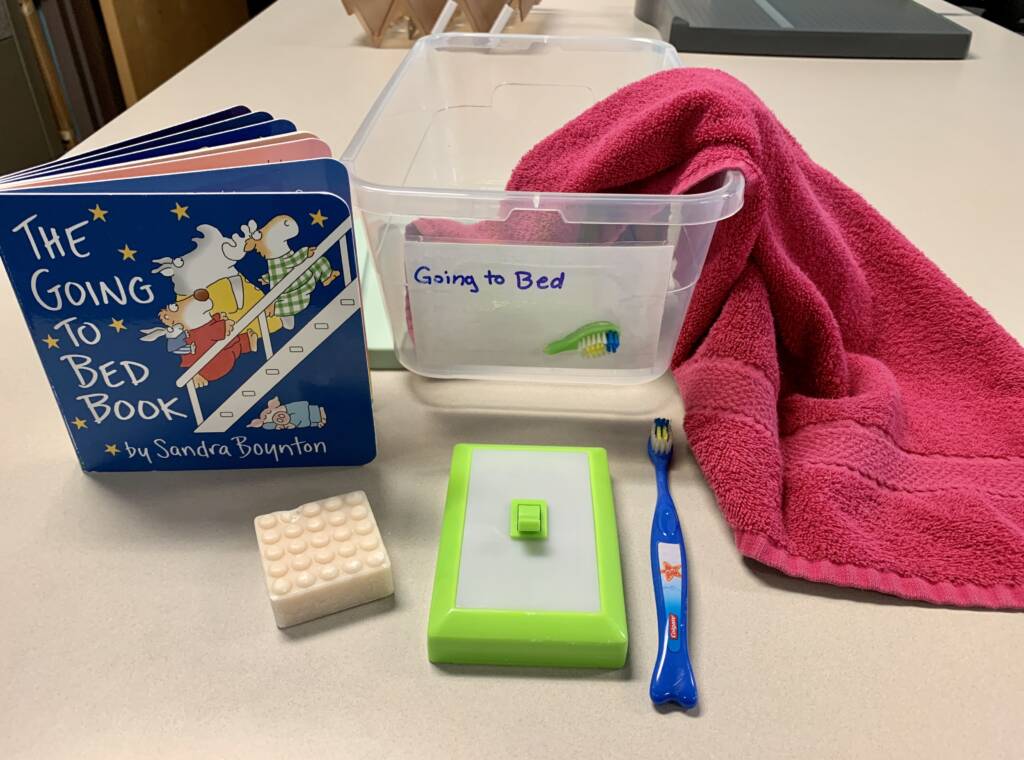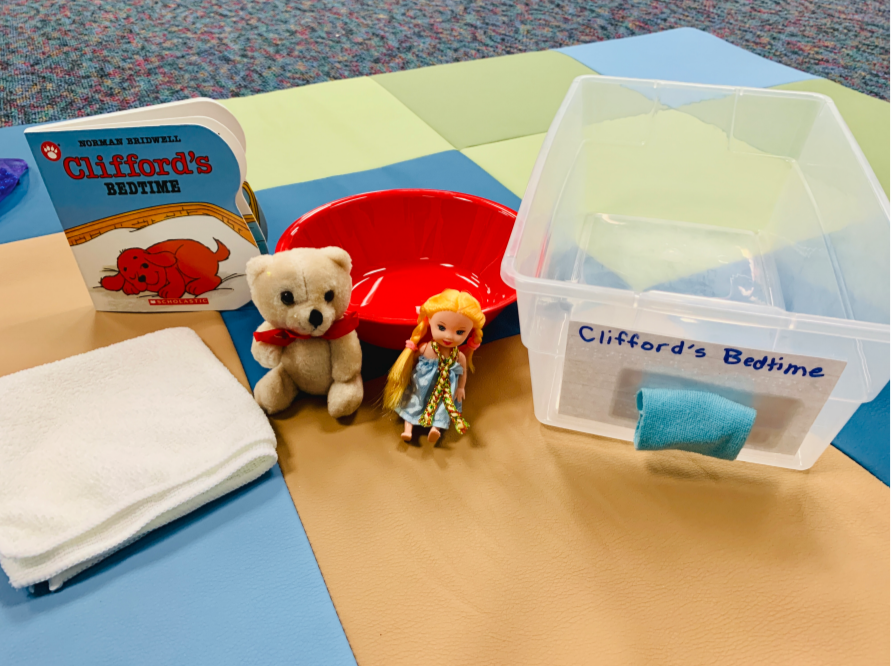As part of the graduate coursework for Visual Impairments and Multiple Disabilities in the Teacher Preparation Program in Visual Impairments at the University of Kentucky, students were asked to complete four projects: a Story Box with at least 10 objects that correspond to the story, picture communication symbols and tactile communication symbols designed to go along with the story, and a talking book to go along with the story or represent concepts from the story.
We are sharing them on Paths to Literacy and hope that others will use them!
Amelia Bedelia by Peggy Parish is such a fun book for all students—whether they have complex needs, low vision impairments, or blindness. Mr. Seibel’s illustrations are colorful and add meaning to the story. Students will “catch” the unwavering joy and passion Amelia Bedelia brings to helping with chores around the house. She takes pride in completing each of her chores well before checking them off her list. Explore this classic by:
- touching items found in the rooms of a house;
- learning to use a list,
- introducing simple chores,
- using dual meanings of language,
- thinking with a “First, Then” mindset, and
- sequencing events
Story Box
What could be more fun for you and your students–young or young adult, literal or abstract thinkers with blindness or visual impairments–than a day with our sweet well-intended Amelia Bedelia? As Amelia Bedelia explores Mr. and Mrs. Roger’s home, she takes students from room to room where it’s hard not to giggle at the way she cleans.
-
THE CONTAINER:
- When teaching independent living skills, use a cleaning caddy to hold Amelia Bedelia’s feather duster, bath towel, scissors, rolling pin, etc. to teach children how to care for their rooms or help with chores.
- I used a box with sections to represent the living room, kitchen and bathroom of the Roger’s grand home. This way, children can explore the spatial layout and movement through the rooms In a home, inside and outside, etc.
- MATERIALS:
- Plastic Box with adjustable sections, roofing shingle, small doorknob, free samples of carpet, tile and linoleum.
- Small apron with pockets (Amelia Bedelia)
- Brailled List (job list left by Mrs. Rogers)
- Rolling Pin and Pie Tin w PlayDoh (baking a pie)
- Swatches of terry cloth and scissors (changing the towels)
- Feather duster and corn meal (dust the furniture)
- Velvet material on a dowel rod, pencil and paper (draw the drapes)
- Appliance bulb, plastic wiring, clothes pin, and light switch panel (turn out lights)
- Bowls of rice and measuring tape/cup (measure two cups)
- Doll outfit and ribbons (dress the chicken and trim the steak)
- And, of course, a piece of Lemon Meringue pie to taste.
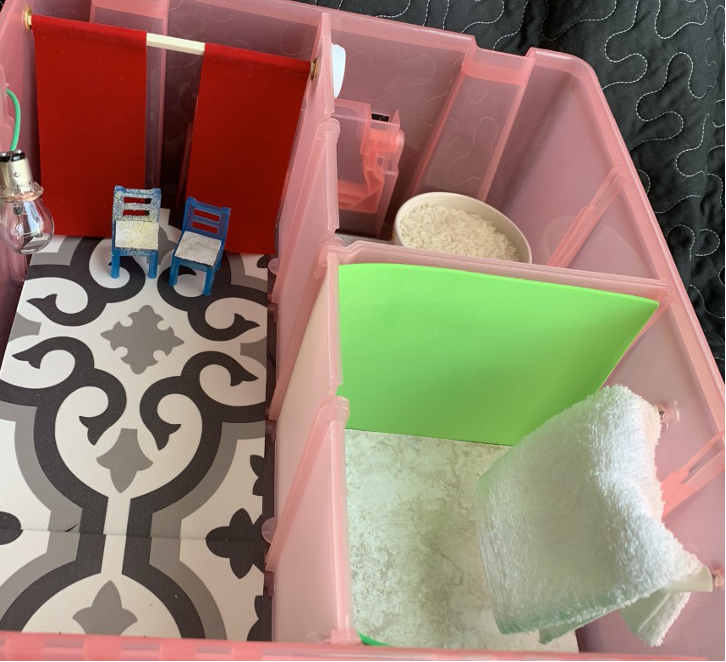
-
PROCEDURE:
-
Develop the understanding that rooms of a house have names, just like friends have names.
- Map the spatial layout of rooms in a house. Discover that walls connect and separate areas (that their bedroom is not isolated).
- Touch or categorize items that belong in each room.
- Explore the textures (roof shingle, carpet, tile and linoleum) found inside and outside.
-
Touch the brailled list and practice tracking skills.
- Ask, “How did Amelia know which jobs were first then next?
- Ask, “How can the list help you retell the story in sequential order?”
-
Name tools used to do chores.
- Match each tool to the appropriate job.
-
Use the softness of the feather duster or the pressure of the rolling pin for sensory seekers as you read the story aloud.
- Explore the feather duster, rolling pin PlayDoh, rice, ruler, etc….
- Pour rice from one cup to another.
-
Cut paper and discuss how its shape has changed. Talk about safety.
- Ask, “Why do we change out dirty towels for clean towels?”
-
Identify clean and dirty.
- Use a cloth or feather duster to wipe away dust.
- Introduce the prefix, “un” and talk about how it changes the meaning of the root word, “dust.”
-
Trace a tactile line drawing of the drapes.
- Ask, “What is another word for drapes?”
- Ask, “Why is it important to open and close drapes or curtains?”
-
Ask, “How do we turn off lights?”
- Explore a light switch. Develop a concept of On and Off.
- Compare a light switch to a communication switch.
- Talk about how to find them close to the door in a room.
-
Ask, “Why does Amelia Bedelia hurry to take the pie out of the oven?”
- Explore cause and effect–when something cooks too long.
-
Pour rice from one cup to another.
- Identify the raised marks on a tactile ruler or measuring cup.
-
Ask, “What is chicken and what is steak?”
- “What tells us how to cook meals?” A Recipe is also a list.
- Use the dual (literal and figurative) meanings of language (change, dust, draw, put out, measure cups, dressing with vegetables and trimming with seasoning)
- Explore Mr. and Mrs. Roger’s emotions using the book’s illustrations.
- Ask, “Why did Mrs. Rogers forget about being angry?” “How do you stop feeling angry?”
-
Develop the understanding that rooms of a house have names, just like friends have names.
Tactile Symbols
Initially, the tactile communication cards for Amelia Bedelia will partner with the story box objects. Emergent learners need to experience the whole object in a meaningful context before the student can transfer that meaning to a part of the object. Allow the student to touch both the whole object and the new tactile symbol as they listen to the story.
As a child transfers these experiences and begins to use symbols to communicate, keep reading Amelia Bedelia. Children love to read their favorite books over and over. They begin to form literacy skills when they anticipate what Amelia will see next on the chore list. It’s so exciting!
This book project, teaches at so many levels:
A higher functioning student may be able to sequence the activities or even discover that language has many meanings. But a student with more complex needs may just experience objects in the home or learn the concept of chores. For either student, this opportunity will open the door for the student to show us what they know and grow to love literacy.
The SYMBOLS
When building a tactile symbols library, the student’s experiences and preferences should drive which objects are selected. Each APH communication card is displayed in portrait position with the straight edge at the bottom. They are grouped predictably by category (color and card shape) so that the student can develop left-to-right muscle memory (tracking) and select them as if reading a sentence.
-
PEOPLE (yellow crown-shape answers, “Who?”)
- Amelia Bedelia, a scrubbing sponge represents the housekeeper.
- Mrs. Rogers, a strand of pearls for her necklace.
- Mr. Rogers, is sporting a stylish moustache
-
PLACES (red barn shape answers, “Where?”)
- Roger’s Grand House, a house key
- Bath, a piece of linoleum
- Livingroom, a piece of carpet
- Kitchen, a spoon with rice
-
ACTIONS (green with a house shape or up arrow, answers “How?”)
- pencil, for drawing the drapes in her notebook
- scissors, to change the shape of the towels
- ostrich feather, that fell out of the feather duster
- notched ruler, to measure the cups
- plastic knife, for trimming the fat from around the steak
- zipper, for getting dressed
- light switches, one at ON and the other pushed OFF
- double wires wrapped in plastic coating, one with zip ties moving away for OPEN and the other moving to the wire for CLOSE
-
OBJECT (white bread shape and answers, “What?”)
- rolling pin, for Amelia’s Lemon Meringue Pie
- towel swatch, for the bath towels Amelia cut
- curtains, she forgot to close
- dust, for the powder she sprinkled on the furniture
- brake light, for the light bulbs she put out(side)
- medicine dosing cup, for measuring rice
- square of cardboard, that the meat was used to deliver the meat
- shaker lid, for seasoning the meat
- oven knob, for baking Amelia’s pie
- pie tin, for serving the pie to Mr. and Mrs. Rogers
-
TIME (blue puzzle shape answers, “When?”)
-
two plastic lid rings detached and mounted on two cards:
- yellow foam fills the left ring and a zip tie tip points here to focus on slowing down and working FIRST.
- green foam fills the right ring and a zip tie tip points here to focus on THEN doing what you want.
-
two plastic lid rings detached and mounted on two cards:
-
EXRESSION (black rectangle to help child express thinking)
- u-shaped box open at the top, one with a pom-pom INSIDE and the other with the pom-pom OUTSIDE
- pairs of parallel double wires wrapped in plastic coating, the first side-by-side for “Hello” and the other apart for “Goodbye.”
- two single plastic lid rings, one is empty for “Yes,” and the other has a line through it for “No.”
-
EXPANSION (grey scalloped top gives details and emotions)
-
Feelings cards use google eyes and a plastic shower curtain ring for the mouth:
- one has the complete ring for surprise,
- an upturned mouth for happy, and
- a downturned mouth with angry eyebrows for angry
-
Feelings cards use google eyes and a plastic shower curtain ring for the mouth:
PROCEDURE: Comprehension questions to check for understanding
- “Who is the main character we all the way through the story?”
- “First Amelia Bedelia made a pie, then what did she do?”
- “What does Amelia Bedelia use to change the towels?”
- “Where is Amelia when she sprinkles dust onto the furniture?”
- “Why do we close drapes?”
- “How should Amelia put out the lights in the living room?”
- “Amelia measured the stacked cups of rice. How did Mrs. Rogers want her to measure the rice?”
- Use the List of chores to retell when Amelia Bedelia finished each job.
- “Why is Mrs. Rogers surprised when she sees the chicken dressed in clothes?”
- “When do you feel angry?”
- “What happens when you cook food in the oven? What happens when you cool it?”
- “What is your favorite dessert?”
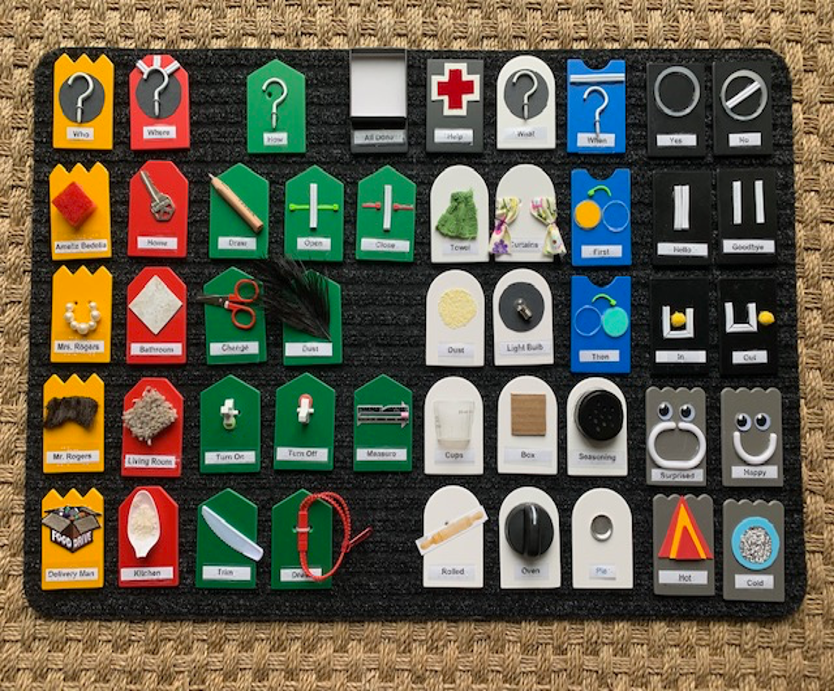
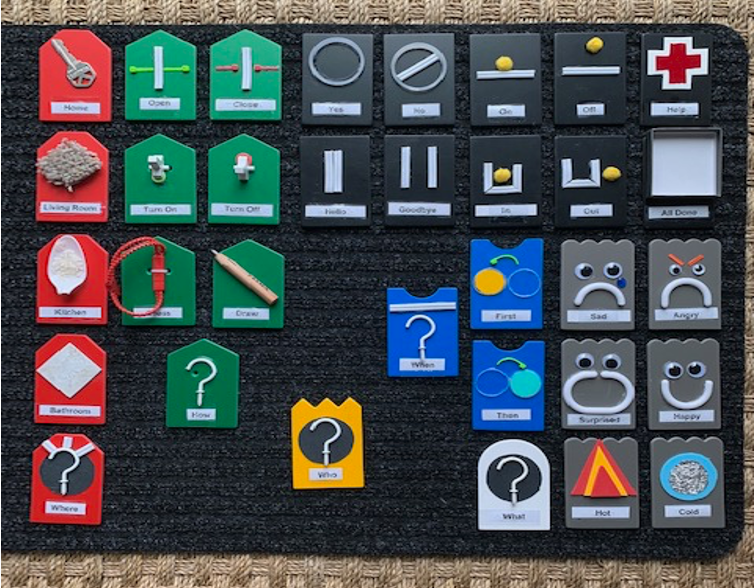
Picture Symbols
Using BoardMaker, each of the familiar 32 picture symbol cards is purposefully designed to complement the “Amelia Bedelia” Story Box and Tactile Communication objects. These can be manipulated on a story board or embedded into a talking book.
These can act as a bridge between concrete real-life objects for concept development and using pictures as a symbol of life experiences. They will continue to foster pre-literacy skills with lateral left-to-right, top-to-bottom hand-eye movements.
- To make the SYMBOLS
- Choose simple bold-lined pictures (from a program such as Boardmaker) to represent characters, actions and story events.
- To create CVI-friendly symbols, be sure to use a high contrast background that’s either black, white, yellow or red so that the picture pops and students engage visually.
- Label pictures using bold Arial 24 font with extra spacing between letters.
- Print each color 4×4” picture on durable cardstock paper, laminate it, and attach a hook and loop Velcro fastener to its back.
-
The SYMBOLS
- Characters: Amelia Bedelia, Mr & Mrs Rogers and delivery man
- Objects: house, the List, rolling pin, oven, towels, scissors, feather duster, couch, curtains, light bulb, clothesline, cups of rice, steak, chicken, ribbons and bows, and pie.
- Actions: drive, bake, change, dust, draw, put out, cool, measure, trim and dress.
- PROCEDURE: After listening to the book, match the picture symbols to each character, object, action and event. Talk about how they match the whole objects of the story box and the smaller parts of objects on the tactile communication cards. Assess whether your student is ready to apply each object’s meaning to picture symbols. Ask these questions:
- “Who are the characters in this story? What are their names?”
- “Point to the picture of Amelia Bedelia’s list.”
- “What does Amelia Bedelia use to change the towels?”
- “Which picture shows the tool we use to dust? (feather duster/cloth)
- “Point to all the pictures of food.” (dough, pie, chicken, and steak)
- “What does a lightbulb look like and what does it do?”
- “Which picture shows OUT?”
- “Amelia measured the stacked cups of rice. How did Mrs. Rogers want her to measure the rice?”
- Use the list of chores to retell when Amelia Bedelia finished each job.
- “Is the picture of the face happy or sad?”
Talking Book Project:
I created a talking book from Peggy Parrish’s “Amelia Bedelia.” I used high contrast simplistic pictures of a character, object, or event in order to capture and hold the attention of students with low vision or complex needs. Below each Boardmaker picture is a corresponding label in large print. I also included sound effects for story actions such as washing hands, a car driving away, and unscrewing lightbulbs. To prompt students to “click” their switch or press enter on their device, I added a page turn signal at the end of each audio clip of me reading the story aloud.

